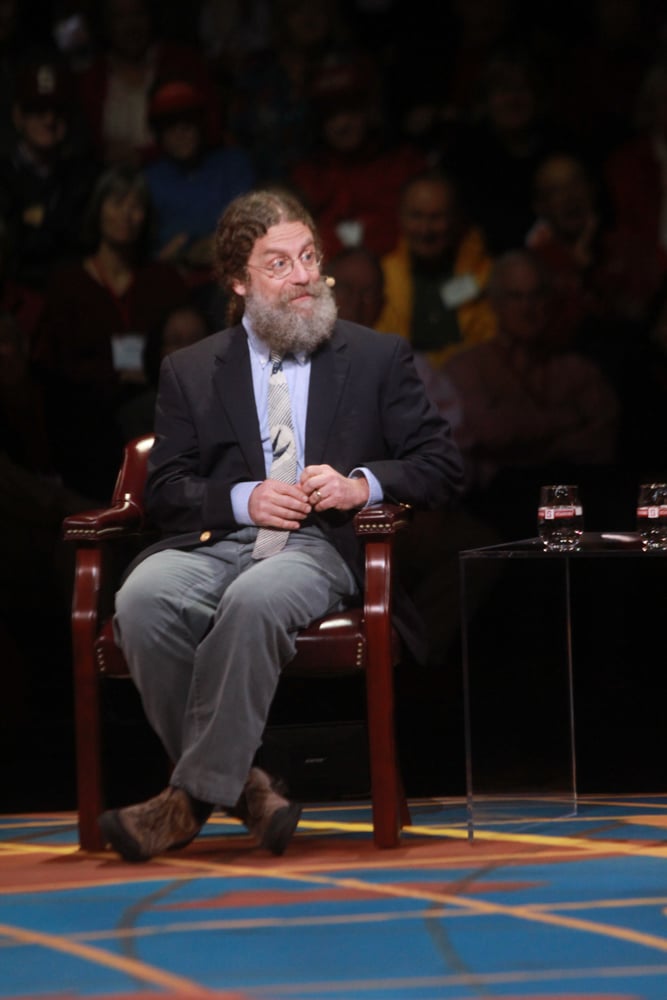While CS 106A: Introductory Programming may be Stanford’s most popular class, BIO 150: Human Behavioral Biology, a class taught by Professor of Biology Robert Sapolsky, may be close behind.

Approximately 400 to 500 students have enrolled in each iteration of the class, which has been offered every other spring quarter for a decade. The students, most of whom are upperclassmen, are usually an even mixture of biology, human biology, psychology or anthropology majors.
While a rumor that Sapolsky planned to stop teaching the course emerged earlier this year, Sapolsky refuted that claim.
“I’ve got no plans to not be doing it for years to come,” he said, easing the worries of any students who haven’t taken the course yet.
The class experience
The popular class’s roots can be traced back to Sapolsky’s experience as an undergraduate at Harvard with Melvin Konner, who had taught a class that explored the biology of human social behavior from many disciplinary angles. Sapolsky described that class as having had the greatest intellectual influence on him.
“[The class] had a huge impact on me, and I vowed to teach something along the same lines when I grew up,” Sapolsky said.
This quarter, Sapolsky’s course consists of three weekly two-hour lectures, during which Sapolsky mostly just speaks and uses some board drawn diagrams but no PowerPoint, according to class teaching assistant Nathan Barnett ’12 M.S. ’14.
According to Barnett, the first half of the course focuses on fields of thought that are crucial to understand before approaching theories on human behavioral biology, such as sociobiology, molecular genetics and ethology. In the second half of the course, these tools are used to explore topics such as sexual behavior, depression and religion.
“The best tool [the class] gives its students is the ability to think critically about new data,” Barnett said. “When The New York Times posts a new controversial study on depression, Bio 150 alums will be ready to rip it apart and make good conclusions for themselves about its validity.”
Practically 90 percent of the course material remains the same year after year, according to Sapolsky, but with each new round of teaching, the curriculum is slightly updated in order to keep up with scientific progress made.
The class culture
Some former students even return to serve as TAs for the class. Doc Edge ’08, Ph.D. ’16 initially took the class as a freshman.
“It influenced me a lot…and it made me more careful about interpreting studies,” Edge said. “Everything I’ve worked on [since then] has been related to the course in some way.”
“It was the best senior spring class I could have asked for…I knew I had to apply [to TA] for the chance to experience the course in a whole new way,” Barnett said.
When asked what he thinks makes the class so popular, Sapolsky credited it is the course material.
“From a purely objective standpoint…I think that this is the most interesting possible subject in the universe to think about, so maybe it reflects some agreement on that,” he said.
Barnett expressed similar sentiments.
“Human behavior and disease can be quite mysterious, and the opportunity for explanations is quite tempting,” he said. “There’s a sense that this class [offers its students] things that apply to their everyday lives.”
However, Sapolsky also attributed the popularity of the class, which has no prerequisites, to the efforts of the teaching to make the class accessible, regardless the amount of science background students have.
Edge and Barnett also argued that Sapolsky’s reputation and famous lecturing style offer further reasons for the popularity of the course.
“Professor Sapolsky’s reputation precedes him,” Barnett said.
“Every [lecture] is well-crafted, funny and insanely interesting for basically the entire time,” Edge added.
When asked what he enjoyed most about teaching BIO 150, Sapolsky focused on the small things.
“Seeing people get excited as various pieces of information come into place in helping to explain human behavior,” Sapolsky said. “And getting to use all the different colored markers that they keep stocked in the lecture halls in the Engineering Quad.”
Contact Silviana Ciurea Ilcus at smci ‘at’ Stanford ‘dot’ edu.
